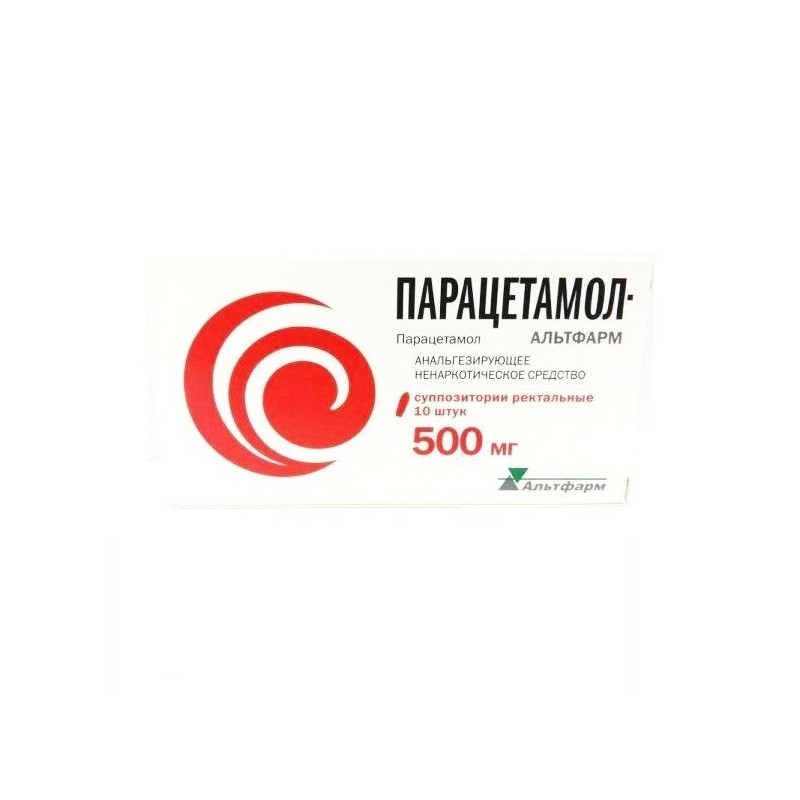



 All payments are encrypted via SSL
All payments are encrypted via SSL
 Full Refund if you haven't received your order
Full Refund if you haven't received your order
Paracetamol tablets: 1 pill contains Paracetamol 200 and 500 mg;
on 10 tab. packaged.
1 pill contains paracetamol 500 mg;
10 or 20 plastic tubes; in a pack of cardboard 1 or 2 tubes.
1 suppository contains paracetamol - 50 mg, 100 mg, 125 mg, 250 mg or 500 mg;
6 or 10 pieces per pack.
Paracetamol syrup for oral administration 2.4%: 1 ml of syrup contains 24 mg of paracetamol;
Excipients: sugar, sorbitol, citric acid, trisubstituted sodium citrate, propylene glycol, ethyl alcohol, riboflavin, aromatic additives, sodium benzoate, water;
in vials of 50, 100 ml.
Paracetamol is a non-narcotic analgesic. It has analgesic, antipyretic and minor anti-inflammatory effects. The mechanism of action is associated with inhibition of prostaglandin synthesis, a predominant effect on the center of thermoregulation in the hypothalamus.
Quickly and almost completely absorbed from the digestive tract.
The maximum concentration of the drug in the blood is determined in 20-60 minutes after ingestion.
Passes through the BBB, penetrates into breast milk (less than 1% of the dose).
Metabolized in the liver to form glucuronide and paracetamol sulfate.Excreted mainly by the kidneys.
Pain syndrome of low and moderate intensity of various genesis (including headache, migraine, toothache, neuralgia, myalgia, algomenorrhea; pain with injuries, burns). Increased body temperature for colds and other infectious and inflammatory diseases.
Hypersensitivity to paracetamol. Pronounced dysfunction of the liver or kidneys. Genetic absence of glucose-6-phosphate dehydrogenase. Blood disorders. Undesirable use during pregnancy and lactation. Be wary of Gilbert's syndrome (constitutional hyperbilirubinemia). Chronic active alcoholism.
Inside or rectally in adults and adolescents weighing more than 60 kg are used in a single dose of 500 mg.
pills are taken orally before meals 3-4 times a day with an interval of 4-6 hours..
Maximum doses: single - 1 g daily - 4 g
Drug in the form of effervescent tablets it is intended for adults and children older than 15 pet (with a body weight of 50 kg or more).
For children aged 6-12 years - 250-500 mg, 1-5 years - 120-250 mg, from 3 months to 1 year - 60-120 mg, up to 3 months - 10 mg / kg. Frequency of use - 4 times / day with an interval of at least 6 hours.
Young children can be added to a bottle with water, tea.
In 5 ml of syrup - 1 teaspoon - contains 120 mg of paracetamol. The dosage for children depends on the age and body weight of the child.
A single dose is 10-15 mg / kg body weight of the child. The maximum daily dose is not more than 60 mg per kg of body weight of the child per day.
Depending on the age, paracetamol syrup is prescribed in the following single doses:
- from 3 months up to 1 year - 2.5-5 ml (1 / 2-1 tsp) or 60-120 mg;
- from 1 year to 6 years - 5-10 ml (1-2 teaspoons) or 120-240 mg;
- from 6 to 14 years - 10-20 ml (2-4 tsp) or 240-480 mg.
Duration of treatment as an antipyretic - no more than 3 days; as an analgesic - no more than 5 days.
Increasing the daily dose of the drug or the duration of treatment is possible only under medical supervision.
In severe renal failure, the interval between doses of the drug should be at least 8 hours. The highest daily dose is 1500 mg.
At therapeutic doses, the drug is usually well tolerated.
Gastrointestinal: possible nausea, abdominal pain; rarely with prolonged use - abnormal liver function.
Allergic reactions: skin rash, urticaria, angioedema are possible.
Urogenital: rarely with prolonged use - renal dysfunction.
Hemic and lymphatic: rarely with prolonged use - anemia, agranulocytosis, thrombocytopenia.
If you experience adverse reactions, you must stop taking the drug and consult a doctor.
Symptoms: pallor of the skin, anorexia, nausea, vomiting, hepatonecrosis (the severity of necrosis directly depends on the degree of overdose).
Treatment: gastric lavage, Activated carbon.
It is used with caution in patients with impaired liver or kidney function. The risk of hepatotoxic action increases with the simultaneous appointment of barbiturates, difenina, Carbamazepine, rifampicin, zidovudine, and other inducers of microsomal liver enzymes. In order to avoid toxic damage to the liver, paracetamol should not be combined with the intake of alcoholic beverages, as well as be taken by persons prone to chronic alcohol consumption.
List B. Store in a dark place, out of reach of children.
Paracetamol